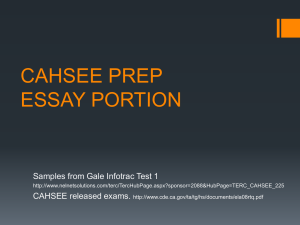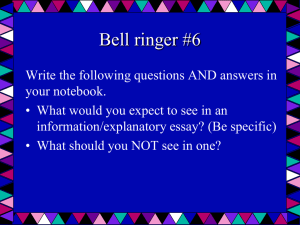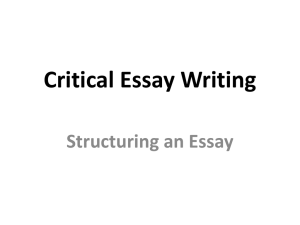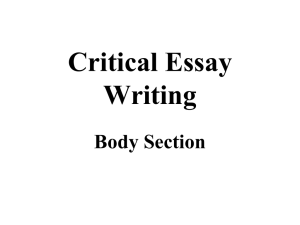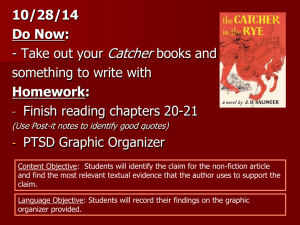MCAT Writing Sample Lecture Notes
advertisement
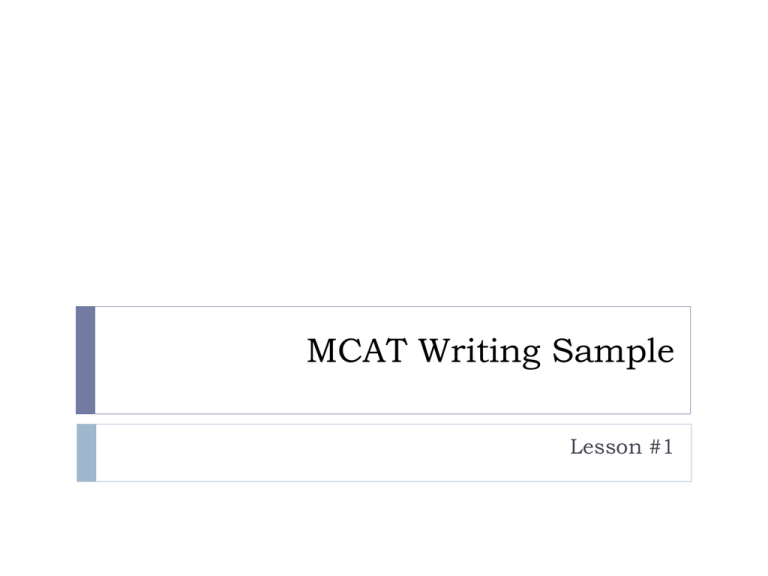
MCAT Writing Sample Lesson #1 Strategies and Tips for Writing Sample Preparation What are medical schools looking for with your writing sample? An indication of strong reasoning/critical thinking skills. Evidence of excellent written communication skills. What do graders expect from your writing? Reasonable/logical, thorough, and well-written responses to a three-task prompt. The sample is one of the first things an admissions official will see. The essay is often read by most schools. The essay is often used to make final decisions about admission. Essay results could be critical if they’re “on the fence” about you. Strategies and Tips for Writing Sample Preparation How will graders evaluate the writing sample? Holistic scoring. Graders, however, do realize writers are under time constraints and that effective writing is typically the product of careful attention and thoughtful, persistent revision work. Scale of 1 to 6 converted to an alphabetical rating ranging from J to T. Therefore, there is allowance for a certain number of mistakes. Graders usually spend around a minute or so evaluating your writing sample. Strategies and Tips for Writing Sample Preparation What skills are rewarded in the writing sample? Developing a central idea. Considering a claim from an opposing perspective. Generating a controlling idea or thesis statement unifying the essay by stating it at the beginning of the paragraph when you first address the 3rd writing task. Offering a counter-point and relevant counter-example. Synthesizing ideas. Combining thoughts and ideas, especially seemingly divergent claims/positions as your controlling idea in the final writing task. Strategies and Tips for Writing Sample Preparation What skills are rewarded in the writing sample? Presenting ideas cohesively and logically. Writing clearly, concisely, and accurately. Making sure ideas are clear and concrete along with smooth paragraph transitions (effective topic sentences). Providing a sample with a minimum of errors. Drafting efficiently with speed and control. Learning how to manage your time effectively so that there’s balance between each writing task. How to Prepare for the Writing Sample Do not underestimate this portion of the test. Realize the close connection between VR and the writing sample. Apply critical thinking skills to both sections. Do not assume applying everyday writing skills will suffice. Practice test -specific strategies and tips frequently. Realize the VR often asks you to analyze arguments and the writing sample requires you to both analyze claims and craft your own. Establish and adhere to a practice schedule. Work to internalize writing sample methods, tips, and strategies. Revisit notes frequently. Practice, practice, practice. Last minute cramming is a recipe for disaster. How to Prepare for the Writing Sample Practice writing essays. Practice under test conditions as much as possible. Learn to evaluate your own writing. Four self-evaluation criteria for the writing sample. Did you address the prompt and tasks accurately? Have you carefully structured/organized your essay coherently? Have you developed your ideas carefully and revealed excellent critical thinking capability? Have you exhibited polished writing skills? Take the time to meta-reflect on your writing process. Read over past writing samples and think about their strengths and weaknesses. How to Prepare for the Writing Sample Make it a habit to engage in outside reading. Find journal articles from various disciplines and respond to the following questions: How would this have sounded ten years ago? 50 years ago? What groups or people would disagree, and why? What philosophy underlies this? What would be an even more extreme restatement of this? The Kaplan Method for the Writing Sample What you can do to: Quickly come up with content. Develop key details. Synthesize details and content. The Kaplan Method for The Writing Sample Ultimately produce a unified, balanced and thoughtful essay. Realize the WS statement is extreme and thus difficult to address. Determine your “first task.” Recognize the critical importance of pre-writing. Which one is easier? Task I (original statement) or Task II(counter-statement)? Note: this applies only to pre-writing. You do NOT want to write out the counter-statement first in the final draft of your writing sample. Develop a habit and a procedure for sketching out ideas before you write for real. Begin by determining reliable criteria upon which to base your reasoning. Reliable criteria to consider: Can you think of any other criteria that might work? Survival/safety. Time. Size/demographics. Education. Moral convictions might work but be very careful here. Avoid the trap of strong, emotional convictions. Establishing criteria can improve your pre-writing. Helps stimulate more ideas. Allows you to coalesce your thinking and unify your writing. Applying the Kaplan Method 1st step is to read and annotate—30 seconds or so. How, precisely, does Task II vary from Task I? Are you carefully adhering to the basic instructions? What words need to be defined and highlighted? Consider words that are abstract, subjective or ambiguous. Use words and terms as broadly as possible. Define/explain these concepts how you see fit. The WS does not test specific knowledge. Plan on exploring one or two terms in the statement for depth in your writing. Applying the Kaplan Method 2nd step is to pre-write your 1st task—One minute or so. If you begin with Task II, you will need to: Begin by deciding which reliable criteria leads most naturally to a concrete example. Don’t begin writing essay until you’ve done all the pre-writing. Jot down a vivid, relevant example for your counter-point. Imagine someone annoying makes the claim and you want to disagree. Don’t worry about complete sentences—just word and phrases. Describe a specific counter-example. Explain the relevance of your counter-example. Use regular transitions to keep the essay unified. Can be real or imagined. Jot down the relevance of this example to your counter-point. Jot down brief notes of precise detail you will use. You can skip around during your pre-writing. It crucial to note things before they slip your mind. Applying the Kaplan Method 3rd step is to pre-write your 2nd task—One minute or so. If your 2nd task is Task I, you will need to: Explain what the statement means to you. Describe an example to provide depth. Jot down a real or imaginary example. Use an effective “hook” to get the reader’s attention. Anecdote, question, provocative statement, personal anecdote, etc. Come back to this if necessary. How do you interpret the statement’s meaning? Jot down a brief interpretation along with explanations of terms/concepts. Don’t get bogged down here. Jot down transitional keywords you will use to bridge paragraphs. For additional detail to provide depth: Answer one or two of the following: What is the history of either side? What assumptions underlie either side? What is the relevance of an example? What are the differences between persons or groups holding these opinions? Applying the Kaplan Method 4th step is to pre-write your 3rd task—One minute or so. For Task III, you will need to: Discuss the criteria for Tasks I and II. Jot down your criteria and a brief rationale for it. Resolve the apparent contradiction. Jot down a reasonable synthesis of the information. What reconciles two apparently opposing claims? End with a memorable conclusion. What signals closure to your writing? Applying the Kaplan Method 5th step is to clarify main idea and plan—One minute or so. Before writing the essay, make some decisions: Do you tend to agree with the statement or counter-statement? Will you take a position in-between? Will you remain neutral? Where will you discuss any terms in the statement requiring explanation? Answering will help determine tone and transitional words. Don’t agonize--just present points logically. Occurs usually in the 1st paragraph. Make sure your discussion is relevant to the overall flow of your ideas. What ideas will you reject/cross out as irrelevant? How will you number your ideas for strong essay organization? What transitional keywords will you use? Use keywords from the VR section to help you. Avoid clichéd keywords. For example, thus, etc. Applying the Kaplan Method 6th step is to write the essay—23 minutes or so. Use one paragraph per task but you can provide additional paragraphs if you have time and more examples or analysis. Consider these topic sentences to help you stay focused: The statement means… One example of when the statement is wrong is… The factors that determine whether the statement is applicable are… Only use the above in your mind. Substitute less obvious more interesting language to say basically the same thing. Don’t deviate extensively from your pre-writing. Applying the Kaplan Method 7th step is to proofread/edit—Two minutes or so. Some common problems: Some English concepts to study: Avoid using “I” unless you have a relevant, personal anecdote. Avoid clichés, slang, and unnecessary repetition. Avoid repetitive sentence patterns and lengths. Avoid sloppy handwriting if you’re not word processing. Sentence fragments. Misplaced modifiers. Pronoun agreement and consistency errors. Misused words—homonyms and malapropisms. Spelling mistakes. Don’t be afraid to make edits on your paper. Keep edit marks neat. Try to double-space your writing. Collaborative Activity—Practice the Kaplan Approach with other Test Takers. Organize yourselves into groups of three. Look over and discuss the activity handout with the guidelines and then go for it. The purpose of this activity is to have you practice putting together a model writing sample so you can: See how the process works. Practice learning the seven steps to a solid writing sample. See how the essays are evaluated. Become more aware of the grading approach to the samples.
